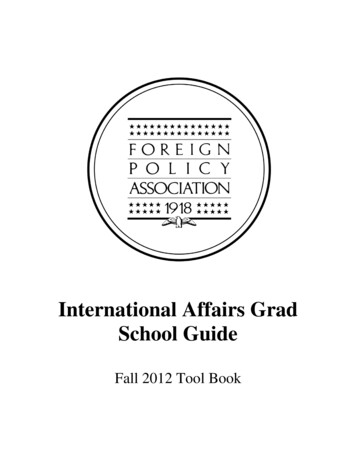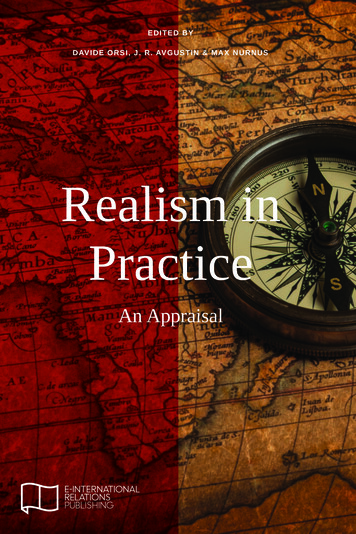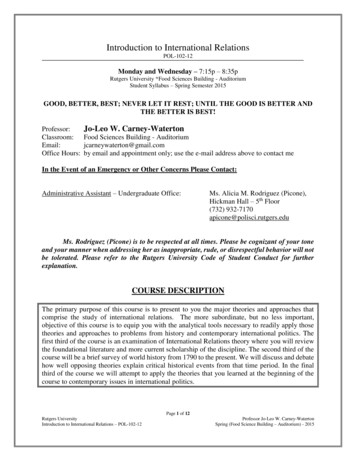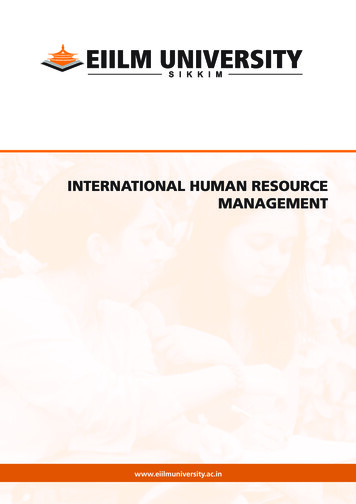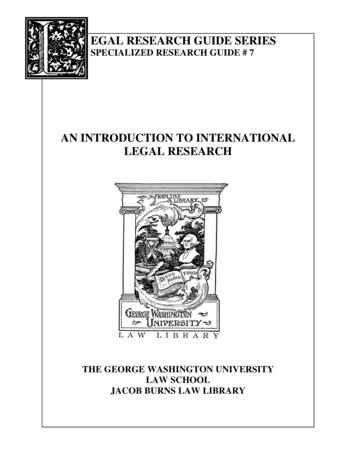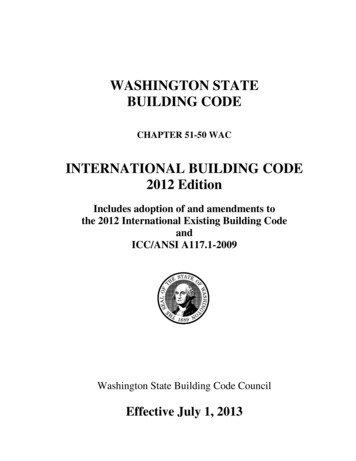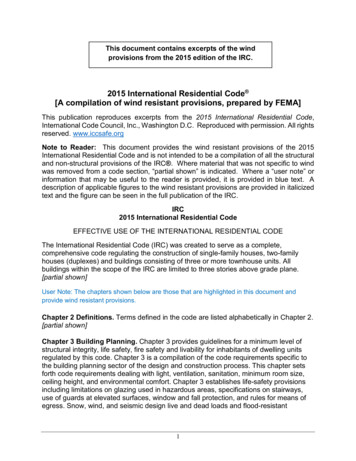
Transcription
1. INTRODUCTIONWHAT IS INTERNATIONAL ECONOMICS ABOUTInternational economics uses the same fundamental methods of analysis as otherbranches of economics, because the motives and behavior of individuals and firms are the samein international trade as they are in domestic transactions. When a bottle of Spanish wine appearson a London table, the sequence of events that brought it there is not very different from thesequence that brings a California bottle to a table in New York-and the distance traveled is muchless! Yet, international economies involve new and different concerns, because internationaltrade and investment occur between independent nations. Spain and the United Kingdom aresovereign states; California and New York are not. Spain's wine shipments to the UnitedKingdom can be disrupted if the British government sets a quota that limits imports; Spanishwine can become suddenly cheaper to British wine drinkers if the foreign-exchange value ofSpain's peseta falls against that of Britain's pound sterling. Neither of these events can happenwithin the United States, where the Constitution forbids restraints on interstate trade and there isonly one currency.The subject matter of international economics, then, consists of issues raised by thespecial problems of economic interaction between sovereign states. Seven themes recurthroughout the subject: the gains from trade, the pattern of trade, protectionism, the balance ofpayments, exchange-rate determination, international policy coordination, and the internationalcapital market.The Gains from TradeEveryone knows that some international trade is beneficial-nobody would suggest thatNorway should grow its own oranges. Many people, however, are skeptical about the benefits oftrading for goods that a country could produce for itself. Shouldn't Americans buy Americangoods whenever possible to help save U .S. jobs? Probably the most important insight in all ofinternational economics is the idea that there are gains from trade-that is, that when countriessell goods and services to one another, this is almost always to their mutual benefit. The range ofcircumstances under which international trade is beneficial is much wider than most peopleappreciate. For example, many U.S. businessmen fear that if Japanese productivity overtakes thatof the United States, trade with Japan will damage the U. S. economy because none of ourindustries will be able to compete. U.S. labor leaders charge that the United States is hurt bytrade with less advanced countries, whose industries are less efficient than ours but who cansometimes undersell U.S. producers because they pay much lower wages. Yet the first model oftrade in this book (Chapter 2) demonstrates that two countries can trade to their mutualadvantage even when one of them is more efficient than the other at producing everything andproducers in the less efficient economy can compete only by paying lower wages. Tradeprovides benefits by alIowing countries to export goods whose production makes relativelyheavy use of resources that are 10calIy abundant while importing goods whose productionma! es heavy use of resources that are locally scarce (Chapter 4). International trade also allowscountries to specialize in produc ing narrower ranges of goods, alIowing them to gain greaterefficiencies of largescale production (Chapter 6). Nor are the benefits limited to trade in tangiblegoods: international migration and international borrowing and lending are also forms ofmutualIy beneficial trade, the first a trade of labor for goods and services, the second a trade ofcurrent goods for the promise of future goods (Chapter 7). FinalIy, international exchanges ofrisky assets such as stocks and bonds can benefit all countries by allowing each country todiversify its wealth and reduce the variability of its income (Chapter 20). These invisible formsof trade yield gains as real as the trade that puts fresh fruit from Latin America in Torontomarkets in February.1
The Pattern of TradeEconomists cannot discuss the effects of international trade or recommend changes ingovernment policies toward trade with any confidence unless they know that their theory is goodenough to explain the international trade that is actually observed. Thus attempts to explain thepattern of international trade-who sells what to whom-have, been a major preoccupation ofinternational economists.Some aspects of the pattern of trade are easy to understand. Climate and resourcesclearly explain why BraziI exports coffee and Saudi Arabia exports oiI. Much of the pattern oftrade is more subtle, however. Why does Japan export automobiles, while the United Statesexports aircraft? In the early nineteenth century English economist David Ricardo offered anexplanation of trade in terms of international differences in labor productivity, an explanationthat remains a powerful insight (Chapter 2). In the twentieth century, however, alternativeexplanations have also been proposed. One of the most infiuential, but still controversial, viewslinks trade patterns to an interaction between the relative supplies of national resources such ascapital, labor, and land on one side and the relative use of these factors in the production ofdifferent goods on the other. We present this theory in Chapter 4. Recent efforts to test theimplications of this theory, however, appear to show that it is less valid than many hadpreviously thought. More recently stilI, some international economists have proposed theoriesthat suggest a substantial random component in the pattern of international trade, theories thatare developed in Chapter 6.ProtectionismIf the idea of gains from trade is the most important theoretical concept in internationaleconomics, the seemingly etern al battle between Free Trade and Protection is its most importantpolicy theme. Since the emergence of modem nation-states in the sixteenth century, governmentshave worried about the effect of international competition on the prosperity of domesticindustries and have tried either to shield industries from foreign competition by placing limits onimports or to help them in world competition by subsidizing exports. The single most consistentmission of international economics has been to analyze the effects of these so-called protectionistpolicies-and usually, though not always, to criticize protectionism and show the advantages offreer international trade.The protectionist issue is especially intense in the United States because of the trendsillustrated by Figure 1-1. Since W orld War II the United States has advocated free trade in theworld economy, viewing international trade as a force not only for prosperity but also for worldpeace. With the growing role oftrade in the U.S. economy from 1965 to 1980, however, manyindustries found that for the first time they were facing foreign competition in their homemarkets. Some of them found the foreign competition too much to handle and appealed forprotection. During the 1970s these demands were opposed by other U.S. industries that werebenefiting from increased export sales. In the 1980s, however, as exports plunged, the mood ofCongress shifted toward protectionism. The Reagan administration resisted this political pressurebut made a series of concessions, limiting imports of Japanese automobiles, European steel,Canadian lumber, and many other goods. Congress recently passed a major new piece oflegislation, the Omnibus Trade and Competitiveness Act of 1988, which significantly toughensU.S. trade policy. Although the opposition of most international economists to protectionremains as strong as ever, there seems to be a real possibility that over the next few years theUnited States will move sharply away from its fourdecade-Iong commitment to the principle offree trade.As befits both the historical importance and the current relevance of the protectionistissue, roughly a quarter of this book is devoted to this subject. Over the years, internationaleconomists have developed a simple yet powerful analytical framework for determin ing the2
effects of government policies that affect international trade. This framework not only predictsthe effects oftrade policies, it allows cost-benefit analysis and defines criteria for determiningwhen government intervention is good for the economy. We present this framework in Chapters8 and 9, and use it to discuss a number of policy issues in those chapters and in the followingtwo.In the real "(orld, however, governments do not necessarily do what the costbenefitanalysis of economists tells them they should. This does not mean that analysis is useless.Economic analysis can help make sense of the politics of international trade policy, by showingwho benefits and who loses from such government actions as quotas on imports and subsidies toexports. The key insight of this analysis is that conflicts of interest within nations are usuallymore important in determin ing trade policy than conflicts of interest between nations. Chapters 3and 4 show that trade usually has very strong effects on income distribution within countries,while Chapters 9, 10, and 11 reveal that the relative power of different interest groups withincountries, rather than some measure of overall national interest, is often the main determin ingfactor in government policies toward international trade.The Balance of PaymentsIn 1987 both Japan and Brazii ran large trade surpluses-that is, each sold more goods tothe rest of the world than it bought in return. Japan's surplus of 96 billion brought complaintsfrom many other countries that Japan was gaining at their expense; Brazil's surplus of 12 billion(which represented a much larger fraction ofthe country's national income) brought complaintsfrom the Brazilians that they were being unfairly treated. What does it mean when a country runsa trade surplus or a trade deficit? To make sense of numbers like the trade deficit,)t is essential toplace them in the broader context of the whole of a nation' s international transactions.The record of a country's transactions with the rest of the world is called the balance ofpayments. Explaining the balance of payments, and diagnosing its significance, is a main themeof international economics. It emerges in a variety of specific contexts: in discussinginternational capital movements (Chapter 7), in relating international transactions to nationalincome accounting (Chapter 12), and in discussing virtually every aspect of internationalmonetary policy (Chapters 16 through 21). Like the problem of protectionism, the balance ofpayments has become a central issue for the United States because the nation has run huge tradedeficits in every year since 1982.Exchange-Rate DeterminationIn February 1985, one U.S. dollar traded on international markets for 260 Japanese yen;in January 1988, a dollar was worth only 123 yen. This change had effects that reached farbeyond financial markets. In February 1985, the average Japanese worker in manufacturing waspaid a wage in yen that, converted into dollars at the prevailing rate of exchange, was only abouthalf that of his U.S. counterpart. Three years later Japanese wages were about the same as U.S.wages. With their labor cost advantage vis-a-vis the United States gone, and in the face ofcompetition from low-wage competitors like Korea and Taiwan, Japanese manufacturers wereinitially forced into layoffs that drove the Japanese unemployment rate to its highest level sincethe 1950s, after which they began investing heavily in acquiring production facilities in othercountriesespecially in the U.S.One of the key differences between international economics and other areas ofeconomics is that countries have different currencies. It is usually possible to convert onecurrency into another (though even this is illegal in some countries), but as the example of thedollar-yen exchange rate indicates, relative prices of currencies may change over time,sometimes drastically.3
The study of exchange-rate determination is a relatively new part of internationaleconomics, for historical reasons. For most of the past century, exchange rates have been fixedby government action rather than determined in the marketplace. Before World War I the valuesof the world's major currencies were fixed in terms of gold, while for a generation after WorldWar II the values of most currencies were fixed in terms of the U. S. dollar. The analysis ofinternational monetary systems that fix exchange rates remains an important subject, especiallysince a return to fixed rates in the fu tureRemains a real possibility. Chapters 17 and 18 are devoted to the working of fixedratesystems, and Chapter 19 to the debate over which system is better. For the time being, however,some of the world's most important exchange rates fluctuate minute by minute and the role ofchanging exchange rates remains at the center of the international economics story. Chapters 13through 16 focus on the modem theory of floating exchange rates.International Policy CoordinationThe international economy comprises sovereign nations, each free to choose its owneconomic policies. Unfortunately, in an integrated world economy one country's economicpolicies usually affect other countries as well. When West Germany rai sed taxes and interestrates in 1981, all of Europe went into a recession; when the United States imposed a tariff onimports of lumber during 1986, the Canadian lumber industry experienced a crisis. Differencesin goals between countries of ten lead to conflicts of interest. Even when countries have similargoals, they may suffer losses if they fail to coordinate their policies. A fundamental problem ininternational economics is how to produce an acceptable degree ofharmony among theinternational trade and monetary policies of different countries without a world government thattel!s countries what to do.For the last forty years international trade policies have been governed by aninternational treaty known as the General Agreement on Tariffs and Trade, and massiveinternationalnegotiations involving dozens of countries at a time have been held. We discuss therationale for this system in Chapter 9 and look at whether the current rules of the game forinternational trade in the world economy can or should survive.While cooperation on international trade policies is a wel!-established tradition,coordination of international macroeconomic policies is a newer and more uncertain topic. Onlyin the last few years have economists formulated at all precisely the case for macroeconomicpolicy coordination. Nonetheless, attempts at international macroeconomic coordination areoccurring with growing frequency in the real world. Both the theory of internationalmacroeconomic coordination and the developing experience are reviewed in Chapters 18 and 19.The International Capital MarketDuring the 1970s banks in advanced countries lent tens of billions of dollars to firmsand governments in poorer nations, especially in Latin America. In 1982, Mexico announced thatit could no longer pay the money it owed without special arrangements that allowed it topostpone payments and borrow back part of its interest; soon afterward Brazi!, Argentina, and anumber of smal!er countries found themselves in the same situation. While combined efforts ofbanks, governments, and countries avoided a world financial crisis in 1982, the debt difficultiesof less-developed countries remained in a state of periodic crisis through 1990. The debt problembrought to the public's attention the growing importance of the international capital market.In any sophisticated economy there is an extensive capital market: a set of arrangementsby which individuals and firms exchange money now for promises to pay in the future. Thegrowing importance of international trade since the 1960s has been accompanied by a growth inthe international capital market, which links the capital markets of individual countries. Thus inthe 1970s oil-rich Middle Eastern nations placed their oii revenues in banks in London or New4
York, and these banks in turn lent money to governments and corporations in Asia and LatinAmerica. During the 1980s Japan converted much of the money it earned from its boomingexports into investments in the United States, including the establishment of a growing numberof U.S. subsidiaries of J apanese corporations.International capital markets differ in important ways from domestic capital markets.Ţhey must cope with special regulations that many countries impose on foreign investment; theyalso sometimes offer opportunities to evade regulations placed on domestic markets. Since theI960s, huge international capital markets have arisen, most notably the remarkable LondonEurodollar market, in which billions of dollars are exchanged each day without ever touching theUnited States.Some special risks are also associated with international capital markets. One risk isthat of currency fluctuations: if the dollar falls suddenly against the Japanese yen, Japaneseinvestors who bought U.S. bonds suffer a capitalloss-as many discovered in 1985-1988. Anotherrisk is that of national default: a nation may simply refuse to pay its debts (perhaps because itcannot), and there may be no effective way for its creditor to bring it to court. This remains a realpossibility for the nations of Latin America; if all of them were to refuse payment; major U.S.banks would Iose heavily.The growing importance of international capital markets, and their new problems,demand greater attention than ever before. This book devotes two chapters to issues arising frominternational capital markets: one on the functioning of global as set markets (Chapter 20) andone on the international debt problem (Chapter 21).INTERNATIONAL ECONOMICS: TRADE AND MONEYThe economics of the international economy can be divided into two broad subfields:the study of international trade and the study of international money. International trade analysisfocuses primarily on the real transactions in the international economy, that is, on thosetransactions that involve a physical movement of goods or a tangible commitment of economicresources. International monetary analysis focuses on the monetary side of the internationaleconomy, that is, on financial transactions such as foreign purchases of U. S. dollars. Anexample of an international trade issue is the conflict between the United States and Europe overEurope's subsidized exports of agricultural products; an example of an international monetaryissue is the dispute over whether the foreign-exchange value of the dollar should be allowed tofloat freely or be stabilized by government action.In the real world there is no simple dividing line between trade and monetary issues.Most international trade involves monetary transactions, while, as the examples in this chapteralready suggest, many monetary events have important consequences for trade. Nonetheless, thedistinction between international trade and international money is useful. The first half of thisbook covers international trade issues. Part One (Chapters 2 through 7) develops the analyticaltheory of international trade, and Part Two (Chapters 8 through 11) applies trade theory to theanalysis of government policies toward trade. The second half of the book is devoted tointernational monetary issues. Part Three (Chapters 12 through 17) develops internationalmonetary theory, and Part Four (Chapters 18 through 21) applies this analysis to internationalmonetary policy.5
2. THE RICARDIAN MODEL1. In this chapter we examined the Ricardian model, the simplest model that shows howdifferences between countries give rise to trade and gains from trade. In this model labor is theonly factor of production and countries differ only in the productivity of labor in differentindustries.2. In the Ricardian model, countries will export goods that their labor produces relativelyefficiently, and import goods that their labor produces relatively inefficiently. In other words, acountry's production pattern is determined by comparative advantage.3. That trade benefits a country can be shown in either of two ways. First, we can think oftrade as an indirect method of production. Instead of produc ing a good for itself, a country canproduce another good and trade it for the desired good. The simple model shows that whenever agood is imported it must be true that this indirect "production" requires less labor than directproduction. Second, we can show that trade enlarges a country's consumption possibilities,implying gains from trade.4. The distribution of the gains from trade depends on the relative prices of the goodscountries produce. To determine these relative prices it is necessary to look at the relative worldsupply and demand for goods. The relative price implies a relative wage rate as well.5. The proposition that trade is beneficial is unqualified. That is, there is no requirementthat a country be "competitive" or that the trade be "fair." In particular, we can show that threecominonly held beliefs about trade are wrong. First, a country gains from trade even if it haslower productivity than its trading partner in all industries. Second, trade is beneficial even ifforeign industries are competitive only because of low wages. Third, trade is beneficial even if acountry's exports embody more labor than its imports.6. Extending the one-factor, two-good model to a world of many commodities does notalter these conclusions. The only difference is that it becomes necessary to focus directly on therelative demand for labor to determine relative wages rather than to work via relative demand forgoods. Also, a many-commodity model can be used to illustrate the important point thattransportation costs can give rise to a situation in which some nontraded goods exist.7. While some of the predictions of the Ricardian model are clearly unrealistic, its basicprediction-that countries will tend to export goods in which they have relatively highproductivity-has been confirmed by a number of studies.1
3. SPECIFIC FACTORS AND INCOME DISTRIBUTION1. International trade often has strong effects on the distribution of income withincountries, so that it often produces losers as well as winners. Income distribution effects arise fortwo reasons: factors of production cannot move instantaneously and costlessly from one industryto another, and changes in an economy's output mix have differential effects on the demand fordifferent factors of production.2. A useful model of income-distribution effects is the specific factors model, whichallows for a distinction between general-purpose factors that can move between sectors, andfactors that are specific to particular uses. In this model, differences in resources can causecountries to have different relative supply curves, and thus cause international trade.3. In the specific factors model, factors specific to export sectors in each country gainfrom trade, while factors specific to import-competing sectors lose. Mobile factors that can workin either sector may either gain or lose.4. Trade nonetheless produces overall gains in the limited sense that those who gaincould in principle compensate those who lose while still remaining better off than before.5. Most economists do not regard the effects of international trade on incomedistribution as a good reason to limit this trade. In its distributional effects, trade is no differentfrom many other forms of economic change, which are not normally regulated. Furthermore,economists would prefer to address the problem of income distribution directly, rather than byinterfering with trade flows.6. Nonetheless, in the actual politics of trade policy income distribution is of crucialimportance. This is true in particular because those who lose from trade are usually a much moreinformed, cohesive, and organized group than those who gain.
4. RESOURCES AND TRADE (HECKSHER-OHLIN)1. To understand the role of resources in trade we begin by examining the effect ofresources on a country's production possibilities. Increases in an economy's supply of a factor ofproduction such as land shift the production possibility frontier out in a based way: an increase inthe land supply shifts the frontier out more in the direction of land-intensive goods than in thedirection of labor-intensive goods. As a result, countries are relatively effective at producinggoods whose production is intensive in resources of which they have a relatively abundantsupply.2. Changes in relative prices of goods have very strong effects on the relative incomesearned by different resources. An increase in the price of the land-intensive good will raise therent earned on land more than in proportion, while actually reducing the wage rate.3. A country that has a large supply of one resource relative to its supply of otherresources is abundant in that resource. A country will tend to produce relatively more of goodsthat use its abundant resources intensively. The result is the basic Heckscher - Ohlin theory oftrade: Countries tend to export goods that are intensive in the factors with which they areabundantly supplied.4. Because changes in relative prices of goods have very strong effects on the relativeearnings of resources, and because trade changes relative prices, international trade has strongincome-distribution effects. The owners of a country's abundant factors gain from trade, but theowners of scarce factors lose.5. In an idealized model international trade would actually lead to equalization of theprices of factors such as labor and capital between countries. In reality, complete factor priceequalization is not observed because of wide differences in resources, barriers to trade, andinternational differences in technology.6. Empirical evidence is generally negative on the idea that differences in resources arethe main determinant of trade patterns. Instead, differences in technology probably play the keyrole, as we suggested in the Ricardian model. Nonetheless, the Heckscher - Ohlin model remainsuseful as a way to predict the income-distribution effects of trade.
5. STANDARD MODEL1. The standard trade model derives a world relative supply curve from productionpossibilities and a world relative demand curve from preferences. The price of exports relative toimports, a country's terms of trade, is determined by the intersection of the world relative supplyand demand curves. Other things equal, a rise in a country's terms of trade increases its welfare.Conversely, a decline in a country's terms of trade will leave the country worse off.2. Economic growth means an outward shift in a country's production possibilityfrontier. Such growth is usually biased-that is, the production possibility frontier shifts out morein the direction of some goods than in the direction of others. The immediate effect of biasedgrowth is to lead, other things equal, to an in crease in the world relative supply of the goodstoward which the growth is based .This shift in the world relative supply curve in turn leads to achange in the growing country's terms of trade, which can go in either direction. If the growingcountry's terms of trade improve, this improvement reinforces the initial growth at home but hurtsthe rest of the world. If the growing country's terms of trade worsen, this decline offsets some ofthe favorable effects of growth at home but benefits the rest of the world.3. The direction of the terms of trade effects depends on the nature of the growth.Growth that is export-biased (growth that expands the ability of an economy to producethe goods it was initially exporting more than it expands the ability to produce goods thatcompete with imports) worsens the terms of trade. Conversely, growth that is import-biaseddisproportionately increasing the ability to produce import-competing goods, improves acountry's terms of trade. It is possible for import-biased growth abroad to hurt a country, asituation that may actually have happened to a mild degree to the United States in the postwarperiod.4. International transfers of income such as war reparations and foreign aid may affect acountry's terms of trade by shifting the world relative demand curve. If the country receiving atransfer spends a higher proportion of an increase in income on its export good than the giver, atransfer raises world relative demand for the recipient's export good and thus improves its termsof trade. This improvement reinforces the initial transfer and provides an indirect benefit inaddition to the direct income transfer. On the other hand, if the recipient has a lower propensity tospend on its export at the margin than the donor, a transfer worsens the recipient's terms of trade,offsetting at least part of the transfer’s effect.5. In practice, most countries spend a much higher share of their income ondomestically produced goods than foreigners do. This is not necessarily due to differences intaste but rather to barriers to trade, natural and artificial, which cause many goods to benontraded. If nontraded goods compete with exports for resources, transfers will usually raise therecipient's terms of trade. The evidence suggests that this is, in fact, the case.6. Import tariffs and export subsidies affect both relative supply and demand. A tariffraises relative supply of a country's import good while lowering relative demand. A tariffunambiguously improves the country's terms of trade at the rest of the word’s expense. An exportsubsidy has the reverse effect, increasing the relative supply and reducing the relative demand forthe country's export good, and thus worsening the terms of trade.7. The terms of trade effects of an export subsidy hurt the subsidizing country andbenefit the rest of the world, while those of a tariff do the reverse. This suggests that exportsubsidies do not make sense from a national
INTRODUCTION WHAT IS INTERNATIONAL ECONOMICS ABOUT International economics uses the same fundamental methods of analysis as other branches of economics, because the motives and behavior of individuals and firms are the same in international trade as they are in dom


